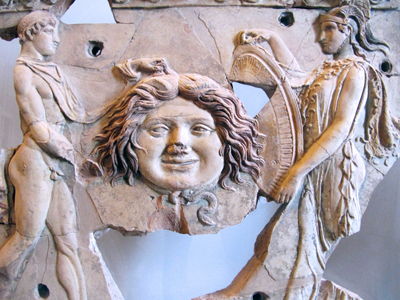SUN AN’ SOUL - DREAM AN’ ROME
PALATINE MUSEUM
The Palatine Museum exhibits works all coming from the Palatine where Augustus, Tiberius, Nero and especially Domitian built the Imperial Domus, so it is obvious that the visitor is faced with masterpieces of great value and historical importance.
Following a chronological order we present:
The Temple of Apollo, built by Augustus in the Augustan area of the Palatine.
The Nero's Transitoria Domus.
The works come largely from Domitian Palace, which for over two centuries was the seat of the successors of Domitian.
TEMPLE OF APOLLO
Augustus built the Temple of Apollo in the vicinity of his house and that of his wife Livia, around the Temple stood the porch of the Danaides, from which come the extraordinary archaic painted pottery exhibited in the museum, of which we offer a glance.
 |
| Palatine Museum, Temple of Apollo - click to enlarge |
Do not miss the extraordinary antefixes, starting from the lion’s head ending with those depicting Silenus and the elephant.
In the cornice of a roof we see two griffinson the sides of a crater and Isis flanked by two sphinxes.
Impressive are the slabs like that showing a Gorgon
with Perseus and Athena at her sides, the one that shows two girls decorating the “Baetilus”, that is the stone which symbolizes Apollo.
And to end, the contest between Apollo and Hercules
for possession of the Delphic tripod.
 |
| Gorgon with Perseus and Athena - click to enlarge |
As you can see there are clear traces of color with which were painted the slabs.
Near the house of Augustus were some rooms, probably belonging to the same emperor, from which comes the famous fresco depicting Apollo Citharist.
DOMUS TRANSITORIA
The Domus Transitoria was built by Nero in the first years of his reign from 54 AD.
The Domus Neroniana, that was connected to the Domus Tiberiana by a long underground porch (cryptoporticus),
was destroyed in 64 during the catastrophic fire that burned a large part of Rome.
 |
| Palatine Museum, Domus Neroniana - click to enlarge |
Moreover, the building constituted a significant change compared to the classic style of Augustus, favoring the illusionistic aspects of the frescoes and the decorative splendor of marble inlays.
The paintings were then called fantastic or fourth style, to differentiate them from previous styles.
The remains of the Domus Transitoria were found in 1912, below the triclinium of the Domus Flavia, erected by Domitian, and in 1959 frescoes and inlays were detached, to be nowadays on display in the Palatine Museum.
The pictorial cycle represents scenes from the Trojan War framed with plant motifs, candelabras and more by following the illusionistic fantasy that characterizes them enriched by inlays in precious stones and glass paste placed in a slate background.
 |
| Domus Neroniana, the pictorial cycle - click to enlarge |
back |

